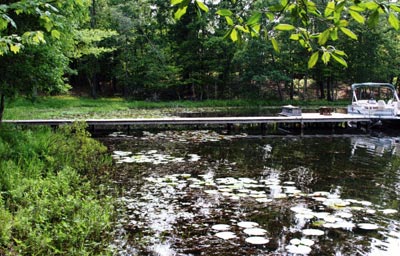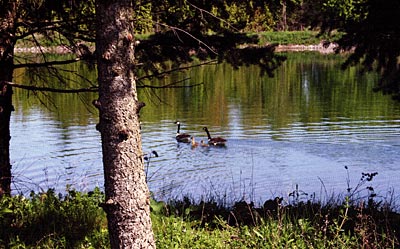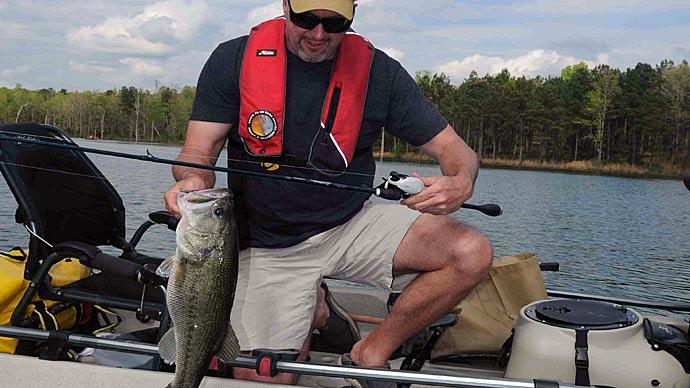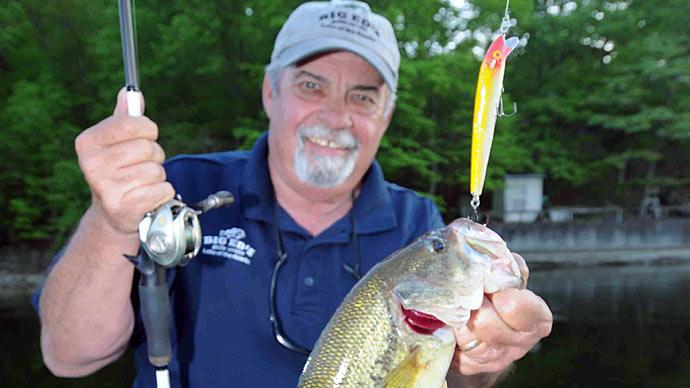
Not much call for pond philosophers, but maybe there should be. Most pondmeisters aren't interested in becoming pond whisperers. That's probably a good thing.
But I'd say most of us want a clean, healthy pond that we don't have to spend more time fixing than enjoying.
For example, we've got two small ponds, side by side. Same size, one-tenth of an acre. Both are hatchery ponds. Both of them are rectangular and both are filled from our well. Both have bluegill sunfish. In theory, these two ponds are the same. In reality, they are polar opposites. There's one, teeny tiny little difference between the two. The North Hatchery pond average depth is about a foot deeper than the South Hatchery pond. Bluegill reproduction in the South pond is off the charts. Not so in the North pond. The North pond is choked with American Pondweed part of the year and we have to treat it. The South pond this year has maintained almost a perfect plankton bloom. Both ponds have fish feeders. The North pond has much bigger fish, the South one has way more fish, considerably smaller individuals.
What's the point, you might be asking?
The South pond has a much different harmony than the North one. Water in the South pond is autonomous, the bloom is fairly constant as it does its natural ebb and flow. The North pond wants to focus its efforts on rooted aquatic plants. If I want my style of harmony in both ponds, we need to spend money on aquatic herbicides, knock out the plants and manage a plankton bloom. Actually, I'll soon be doing that, primarily because we'll need to harvest fish this fall and give them a new home in someone else's fishing lake.
What does Pond Harmony mean for your pond? Better yet, how do you achieve it? It's truly not enough for guys like me to climb up on our little pedestals and just tell you to watch your water, or be sure to selectively harvest some fish. It's not a menu to choose a few items at a fast-food pond management drive through.
Achieving your pond's balance is about understanding the fundamental concepts of biology, mixed with some basic chemistry (it's not scary, I promise), an attention to perceptions of details such as water color, what's growing, and behaviors of creatures in and around your water, mixed with artful decisions. Stir in your goals and some common sense, and you can have Pond Harmony.
Holy cow, you might be thinking. What in the name-of-nature is this nut-case pond guy talking about?

Step out on the dock or amble to the shore of your favorite pond and look at the water. Does it look good to you? If it doesn't, ask yourself why it doesn't. Too green? Too clear? Not clear enough? Muddy? Next, think about the consequences of that water in relation to your goals and what you want. If you think it looks good, it probably is.
What about the plants? Too much, too thick, in the wrong places? Maybe you have zero plants. To understand harmony, you need to understand balance. Nature is like a see-saw at the playground when you were kids. It goes up and down. The closer you can keep it to level, the closer to harmony and balance you are.
Here's what I'm talking about. Take our South Hatchery pond. Its water has been mostly constant all year, starting way back in the spring. I look at it several times each week. All year, I've been pleased with the natural swings of its bloom. I influence it by adding well water to make up for evaporation loss, but have done nothing except feed the fish in it. Because the water is stable, the fish are thriving in a minimally stressful environment. The biggest stressors those fish have is this thing we have in Texas. We call it "summer." Because the water is in harmony, it passes that level playing field to its inhabitants. The plankton bloom has worked to minimize growth of rooted plants with the exception of some Chara. I just noticed that this morning. It's not a problem.
The North Hatchery pond is a different animal altogether. For three weeks it was 60% covered with floating mats of algae, with some dead algae clinging to expanding mats of American and Bushy pondweed. I let the pond drawdown two feet, then filled it quickly with fresh well water. Some of the peripheral plant life roasted on the shore and much of the algae disappeared. Today, the pond is about 25% covered with rooted plants. I've let it evaporate down another foot, will let it drop some more, then fill it again. That strategy is focused on trying to keep the plants at bay by trying to manage nutrients more toward a natural plankton bloom. Time will tell how well that works in this stubborn pond.
For your pond, reaching harmony and balance begins by observing how each element of your pond treats the others. Think about it this way. Everything starts with water. Spring floods in much of the nation altered our water. Some of those changes were good, some not so good. I've seen floods flush nutrient-rich ponds to offer a cleansing. I've seen others take stable waters and completely upset their balance.
The biology of what lives in water can get pretty complicated, but look at it this way. Everything that grows in water, everything, is in response to a stimulus. Sometimes that stimulus is a competitive opportunity, sometimes it's a localized push from that environment because several things just seemed to happen at the right time.

Here's what I mean. Say you are happy with your pond's water. Let's assume the water is happy with itself. Something is going to grow. Those somethings may be microscopic, they may be insects, they may be plants. As stuff grows, it competes. There's competition for nutrients and food. There's competition for space. A simple example to follow (that we can actually see) is plants. Early in the year, algae dominate most ponds. When there are floating mats of dead algae, along with filaments of growing algae, they dominate those areas, effectively out-competing other plants. But, come summer, algae mostly wanes, giving up its nutrients and space for more patient, warmer-water type rooted plants—or plankton, given the right circumstances. That's part of that balance thingy. As those rooted plants begin their growth journey, they are extracting food from pond bottom soils. Depending on the species of plant, they may also be capturing food, such as minerals and micro-nutrients, from the water as they provide a substrate for periphyton and bio-film. Look on the bottom of an underwater plant's leaf some time. There's more than the leaf. As these plants grow, they become habitat for all kinds of living things. Insects thrive, which attracts bigger insects and small, newly hatched fish. Now we're beginning to see harmony. The water serves its inhabitants, which affects the water and its quality. Without plants, water can only receive oxygen from the air. Plant lives matter. Plants provide habitat and some food sources for small fish. Those small fish influence bigger fish. Water influences the plants; the plants influence quite a bit of their localized environment. In a harmonious pond, those plants are dynamic, giving way to other species and not becoming invasive. That's why professional pond managers seem to harp about diversity under water. We want diversity of plant life, offish species, of different sizes of fish, all in great shape. We want consistently healthy water to support all these different parts of the pond management puzzle as they play on the see-saw of their underwater playground.
Balance isn't static. The see-saw is either going up or down, all the time. We get too much plant life, we aren't happy. If our fish aren't growing as we expect, we need to nudge their see-saw. That's part of our opportunities as pond managers. The hard part is studying, watching, and then understanding enough to know when to push on a see-saw that should be going up instead of down.
As you ponder all this stuff, keep it simple. Good water is a good start. Keeping plants where we want them, or better yet, where they belong, increases our odds of winning this playground race. Add your fishery and its tendencies, aesthetics, and people to enjoy the fruits— that's when you have pond harmony.
If your gorgeous puddle is harmonious, consider yourself blessed. If you need to nudge the see-saw, understanding what needs to be nudged and how to do it is important.
Remember, as you push that see-saw, the other side of it responds.
Your pond will do that, too.
Reprinted with permission from Pond Boss Magazine



